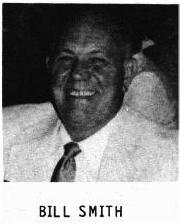Worker of the Month - Bill Smith
by Cindy
Arent
Issue No. 209 - September 1990
With all of the activities of the summer months, such as the N.C.C. Convention, the N.C.C. Picnic, vacations, etc., the Cordial's Study Group has not had time to get together at a regular meeting to interview and film a "Worker of the Month." We are trying to get our meeting schedule back in order, as we have several interesting workers lined up for the coming months.
In July, we did talk Bill Smith into narrating a taped "Tour of the Factory." With the recent rumors of vandalism and the deteriorating condition of the factory, we felt that someone should get some film of the factory before it disappears. From this tape and a short phone interview, we have gathered enough information to make Bill Smith the August "Worker of the Month."
BILL SMITH - WORKER OF THE MONTH
 Bill Smith worked at the Cambridge Glass factory during
the summers of 1942 & 1943. While there he held the position of
"carry-in" boy. The title of the job was appropriate since Bill was
only a boy of 14-15 yrs. at the time. Since Bill was still in high
school, he only worked during vacations when the factory added extra
help for the summer.
Bill Smith worked at the Cambridge Glass factory during
the summers of 1942 & 1943. While there he held the position of
"carry-in" boy. The title of the job was appropriate since Bill was
only a boy of 14-15 yrs. at the time. Since Bill was still in high
school, he only worked during vacations when the factory added extra
help for the summer.
Bill's family home was close to the factory. It was only a short distance for him, and his father, to walk to work each morning. Bill's' father, Ed Smith, worked as a furnace man at the Cambridge factory.
As carry-in boy, Bill's main job was to carry each piece of finished glass from the shop to the lehr. The glass was carried using either a paddle or fork with a long handle. The carry-in boy would repeatedly place one end of this tool on the marvering table where he would receive the glass from the finisher. As each piece was finished, it would be placed on either the paddle or fork and he would carry it to the lehr where it would be slowly cooled.
After placing a piece of glass in the lehr, Bill would return to the marvering table where he would make a chalk mark to keep track of the day's production. The chalk marks were typically made in groups of ten; six straight lines, two diagonal lines, top, and bottom. At the end of the day, the count of the day's production was turned in by the shop's presser or blower.
One of the benefits of being a carry-in boy was the result of being responsible for buying the lunches for the men in his shop. The men knew that if they waited until the lunch whistle blew, the lines at the cafeteria would be long. In order to avoid this, they would begin to cover for the carry-in boy about half-hour early. During this time, the carry-in boy would gather the lunch orders and then go to the cafeteria to get the men's lunches.
Cafeteria lunches were paid for by using books of tickets with .05, .10, .25, .50 cent or $1.00 values. The books of tickets were purchased through the paymaster. Usually the men working in the shop would give the carry-in boy extra tickets for his efforts. As a result, many times a carry-in boy would get his lunch free.
Since Bill was classified as "extra help," he was not guaranteed a job each morning when he reported to work. All of the extra help would gather in the large room in the front of the factory where the time clock was located. Here they would wait until the foreman determined how many extra workers were needed for the day. At some point, Mr. Mosser would come down to choose the workers that were needed, and the rest were sent home. According to Bill, it was wise to stick around for awhile, since often Mr. Mosser came down more that once.
One of the favorite ways to pass the time, while waiting for work, was to pitch pennies. The boys would gather on one side of the room near the paymaster's window and take turns pitching pennies at a hole in the floor, just below the time clock. If your penny went into the hole, you got to pick up all the other pennies on the floor. Even though the time clock has long since been removed, Bill was able to locate the hole, during the video taped factory tour.
The tape of Bill gives a very good tour of the front end of the Cambridge factory. He describes the mold shop, hot metal department, and what various cabinets and racks were used for. This tape will eventually be available for viewing at our Museum.
